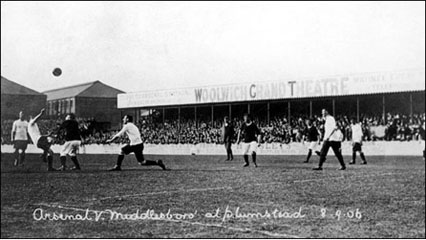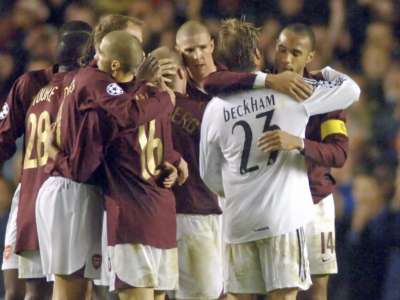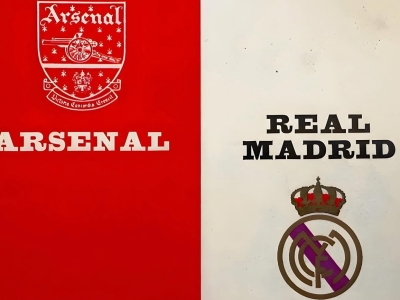Like many other clubs from the period, Middlesbrough Football Club were founded in 1876 by members of the Middlesbrough Amateur Cricket Club as a means of remaining fit during the winter months. The club remained amateur, however in 1889 a group of Middlesbrough players grew disaffected with their amateur status and formed breakaway professional club Middlesbrough Ironopolis FC. That same year, Middlesbrough began competing in the Northern League while Ironopolis entered the same league the following year. On their first three season in the Northern League, Ironopolis won a hat-trick of Northern League titles, while Middlesbrough FC finished runners up in each season.
In 1892, both sides felt that the town of Middlesbrough had a better chance of securing a place within the Football League if they amalgamated and so an application to join was filed under the name of Middlesbrough and Ironopolis Football and Athletic Club. The proposed club however received only one vote in its application, quite possibly due to the reason that most of the Northern and Midlands clubs didn’t fancy a long trek to Middlesbrough. The failure of this application meant that the planned merger was shelved and both clubs remained independent. Twelve months on, Middlesbrough Ironopolis succeeded in being elected to the Football League and competed in the Second Division in 1893/94 alongside Woolwich Arsenal.
On competing within the Football League, through the early use of football agents Ironopolis practically built their side up from scratch. Arsenal’s first visit to Middlesbrough came in late February 1894 at the Ironopolis’s Paradise Ground (very rarely is anywhere in Middlesbrough described as ‘paradise!’). Arsenal left the north east with a 6-3 victory with goals for Frederick Davis, two for James Henderson and a hat-trick for Walter Shaw. Two weeks later, back at Plumstead’s Manor Ground, Walter Shaw was on target again as Arsenal picked up both points with a 1-0 win. In 1893/94, Ironopolis finished eleventh out of fifteen clubs. At the end of the season however, the club were in financial dire straits and folded after just one season in the Football League.
After Ironopolis left the Football League, Middlesbrough FC continued to compete within the Northern League and won three titles out of four between 1894 and 1897. The club remained amateur however and won the FA Amateur Cup twice in four seasons between 1893/94 and 1897/98. In 1899, Middlesbrough FC turned professional and their application – backed by both of their rivals in the north east, Newcastle United and Sunderland - to join the Football League Second Division was accepted. Boro’s first fixture against Woolwich Arsenal came with their visit to Plumstead’s Manor Ground in late September 1899. The Gunners ran out 3-0 winners with goals from Andrew McCowie and two for Herbert Shaw.
Boro’s first season in the Football League ended without a single away win, however they secured their first win over Arsenal at Ayresome Park in February 1900 by inflicting a 0-1 defeat on the Gunners. In their first season, Boro finished fourteenth out of eighteen clubs. Boro’s first away win over Arsenal came in October 1901 by inflicting a 0-3 defeat on the Gunners at the Manor Ground. That same year, Boro won promotion to the First Division by finishing as runners up in the Second Division. The earliest footage of a Boro match is an away trip to Notts County in 1902. By this point, Boro were playing their home games at the Linthorpe Road West Cricket Ground. However, their success required Boro to find a new home and on the site of Ironopolis’s old home at the Paradise Ground, their new Ayresome Road home was built in 1903.
In January 1904 footage of Tees-Wear Derby was captured on film, where Boro were defeated 1-3 by Sunderland. On Arsenal’s promotion to the First Division in 1904, their first visit to Ayresome Park came in September, however they suffered a 0-1 defeat. In the first decade of the twentieth century Boro spent big money on acquiring Alf Common from Sunderland for a record £1,000 in 1905, who later on in his career turned out for Woolwich Arsenal. Middlesbrough also captured the famed England forward Steve Bloomer from Derby County a year later. Bloomer’s first visit to the Manor Ground with Boro in September 1906 however would be described in a report for the London Daily News as ‘gloriously one-sided’.
Two goals for Charlie Satterthwaite gave Woolwich Arsenal a 2-0 win, though the London Daily News piece on the match described that the score: ‘does not indicate such an overwhelming victory as the home team actually gained’ and that ‘neither of the famous pair (of Common and Bloomer) had any disposition to work….what seemed to be wrong with Middlesbrough was that all its stars (!) were in the forward line and all its triers in the rear’. Their appraisal of Arsenal in contrast was that: ‘altogether the Woolwich attack was irresistible on Saturday and entitled to at least two more goals to mark its superiority’.
In 1913/14, Middlesbrough achieved their highest ever league finish to date when they came third in the top tier. They were however never really in the title race and were eight points behind that season’s champions Blackburn Rovers under a two points for a win system. Boro’s first visit to Highbury came in late March 1920, where Arsenal ran out 2-1 winners with goals for Billy Blithe and Frederick Groves (not related to either Vic or Perry). Boro’s first run in the top tier lasted twenty two years, until finishing rock bottom in 1923/24 and ten points adrift of safety. Middlesbrough returned as second tier champions in 1926/27, fired by striker George Camsell who bagged fifty nine goals in one season – then a record which would last for just one further season before surpassed by Everton’s Dixie Dean.
Camsell went on to become Middlesbrough’s top scorer for ten straight seasons, though couldn’t stop Boro finishing rock bottom of the old First Division the following season. Middlesbrough came to Highbury that November to face Arsenal for the first time during Herbert Chapman’s reign. The Gunners ran out 3-1 winners with goals for Joe Hulme and two for Charlie Buchan, while George Camsell would be on target for Boro. That same year, a silent Pathe piece shows footage of when Boro faced a potential Cup upset against fellow north eastern side South Shields in the third round of the FA Cup. The latter side were actually a League club during the 1920s, and lying bottom of the Second Division. At the end of that season, they fell into the Third Division North before folding in 1930.
The side reformed as Gateshead AFC and retained their place in the Football League until 1960, when they failed re-election and were replaced by Peterborough United before finally falling into liquidation in 1973. Back in January 1928 however, they suffered a 3-0 loss to Middlesbrough at Ayresome Park. In 1928/29, Boro bounced back as Second tier champions again and would spend the rest of the 1930s in the old First Division. There followed a run of fixtures with Arsenal which rained goals (in fact, as many as ninety four in just twenty fixtures in the League and FA Cup – an average of 4.7 goals per game!).
On route to winning their first trophy – the 1930 FA Cup – Arsenal beat Middlesbrough 2-0 at Ayresome Park in the fifth round with goals for Jack Lambert and Cliff Bastin. On the road to Arsenal’s first League title the following season, Boro’s visit to Highbury in late November saw the Gunners run out 5-3 winners with two goals for Cliff Bastin and a hat-trick for Jack Lambert. Back at Ayresome Park the following March, on the way to the title Arsenal picked up a 5-2 win with two goals for David Jack and a hat-trick for Jack Lambert. Arsenal’s return to Ayresome Park in 1931/32 a week prior to Christmas saw the exact same score line, with goals for Jack Lambert and two apiece for David Jack and Cliff Bastin.
A week after losing the 1932 FA Cup to Newcastle, Arsenal stood three points behind leaders Everton as Middlesbrough came to Highbury. Boro did Arsenal a big favour the week prior by beating Everton 1-0 back at Ayresome Park. Arsenal ran out 5-0 winners with two goals apiece for Jack Lambert and Cliff Bastin and a Middlesbrough own goal. Up at Goodison Park however, a 1-0 win for Everton meant that they secured the title and Arsenal – failing to retain their title – ended the season trophy-less. In looking to win their title back in 1932/33, in late November after a run of five straight wins Arsenal lost pole position to Aston Villa on goal average after a 3-5 defeat up at Villa Park.
However, a 4-2 victory over Middlesbrough seven days on, with goals for David Jack, Joe Hulme and two for Ernest Coleman saw the Gunners reclaim the top spot after Villa crashed to a 2-5 defeat to Man City. Two months later, Middlesbrough’s 4-1 win over Stoke in the fourth round of the FA Cup would be captured by Pathe News. Boro’s FA Cup run however ended the following round after a 0-3 away defeat to Birmingham. By the following April, the main title challenge to Arsenal came from Sheffield Wednesday. After a run of four games without a win, Arsenal got back on track with a 5-0 home win over Aston Villa.
The following week, Arsenal visited Ayresome Park to play Middlesbrough. The Gunners ran out 4-3 winners with goals from Cliff Bastin and a hat-trick for Joe Hulme. A 0-4 defeat for Sheffield Wednesday that same day meant that Arsenal gained a four point cushion at the top of the table and by the end of the month, the title returned to Highbury. On the way to retaining the title in 1933/34, Arsenal hammered Boro 6-0 at Highbury in late September with goals for Ray Bowden, Cliff Bastin and two apiece for Ralph Birkett and David Jack. By Christmas of 1933, Arsenal held a four point cushion at the top of the old First Division after four straight wins.
However, there after came a run of two draws followed by three straight defeats by early February for the Gunners which left Arsenal two points behind Derby County who overhauled them at the top. Arsenal then travelled to Ayresome Park and goals for Ralph Birkett and Ray Bowden gave the Gunners a 2-0 win – the first of three straight wins which took Arsenal back to the top of the table. Boro had to wait another fourteen months to face Arsenal again, twice over the course of Easter weekend in 1935. On Good Friday at Highbury, Arsenal thumped Boro 8-0 with goals for Pat Beasley, Cliff Bastin as well as two for Welshman Ehud ‘Tim’ Rogers on his debut after signing from Wrexham and four goals for Ted Drake.
After a 1-0 win at home to Huddersfield the following day, Arsenal travelled to Ayresome Park for the return fixture on Easter Monday. As described by Andy Kelly’s ‘The Arsenal History’ website, a Ted Drake goal after six minutes gave the Gunners a 1-0 win over a Middlesbrough side battling relegation in 21st place. That same day, a 1-1 draw for second place Sunderland away at Preston North End meant that Arsenal could not be caught at the top of the table and a hat-trick of League titles was secured. As for Boro, that season they avoided relegation by one point while Spurs finished rock bottom.
By the following December, only one point separated Arsenal and Middlesbrough standing in fourth and sixth place respectively. Despite winning three titles on the bounce, the Gunners were quite some way off the pace standing eight points behind leaders Sunderland. After the game was called off due to thick fog on the Saturday, the following Monday afternoon in front of a diminished crowd of just 23,365, Arsenal picked up both points with two goals again from Ehud Rogers. ‘Tim’ was never a big name in Arsenal’s history and the four goals scored against Boro during 1935 accounted for four fifths of his five goals for Arsenal, before he moved on to Newcastle the following year.
By the time Arsenal came to visit Middlesbrough on Good Friday in April 1936, they stood twelve points behind Sunderland at the top of the table and needed a win to keep their faint hopes alive. On the scoresheet for Boro were two former Arsenal players – Ralph Birkett and Ernest Coleman. Goals for Ray Bowden and Cliff Bastin meant that the Gunners were held to a 2-2 draw and Arsenal’s long reign as English league champions was over. In 1936/37, Middlesbrough visited Highbury in late November. Arsenal were languishing in eighth position, while Boro were two points above in Sixth place. Arsenal however leapfrogged Boro after a 5-3 win, with the points secured with goals from Ray Bowden, Ted Drake, Cliff Bastin and two goals for Jackie Milne who later moved on to Middlesbrough a year and a half later.
By the time that Arsenal met Boro in the return fixture at Ayresome Park in late March 1937, the Gunners had climbed back to the top of the league and were three points ahead of Middlesbrough in third place. Ray Bowden was on target for Arsenal, though the Gunners were held to a 1-1 draw. By the end of the season, the title would be won by Man City, while Arsenal finished five points behind in third and Boro languished in seventh place. Boro visited Highbury again late on the following October. Arsenal were in sixth place but just three points off the top of the table. The Gunners were just two points ahead of Middlesbrough, though Boro were as many as six places lower in twelfth place. Boro however managed their first win over Arsenal for eight years, by inflicting a 1-2 defeat on the Gunners.
Arsenal visited Ayresome Park in early March 1938, by which time the Gunners had climbed to the top of the table despite at that point winning just four games away from home in the league. Boro however, after six straight wins, did the double over Arsenal by inflicting a 1-2 defeat. The Gunners though won back their title on the final day of the season, with a 5-0 win over Bolton at Highbury, overhauling Wolves who lost their final game of the season to Sunderland up at Roker Park. Middlesbrough finished six points behind in fifth, meanwhile reigning Champions Man City were relegated after being kept off of the bottom of the table only on goal difference. In what was an oddity of a league season however, in 1937/38 relegated City were only sixteen points behind newly crowned champions Arsenal!










